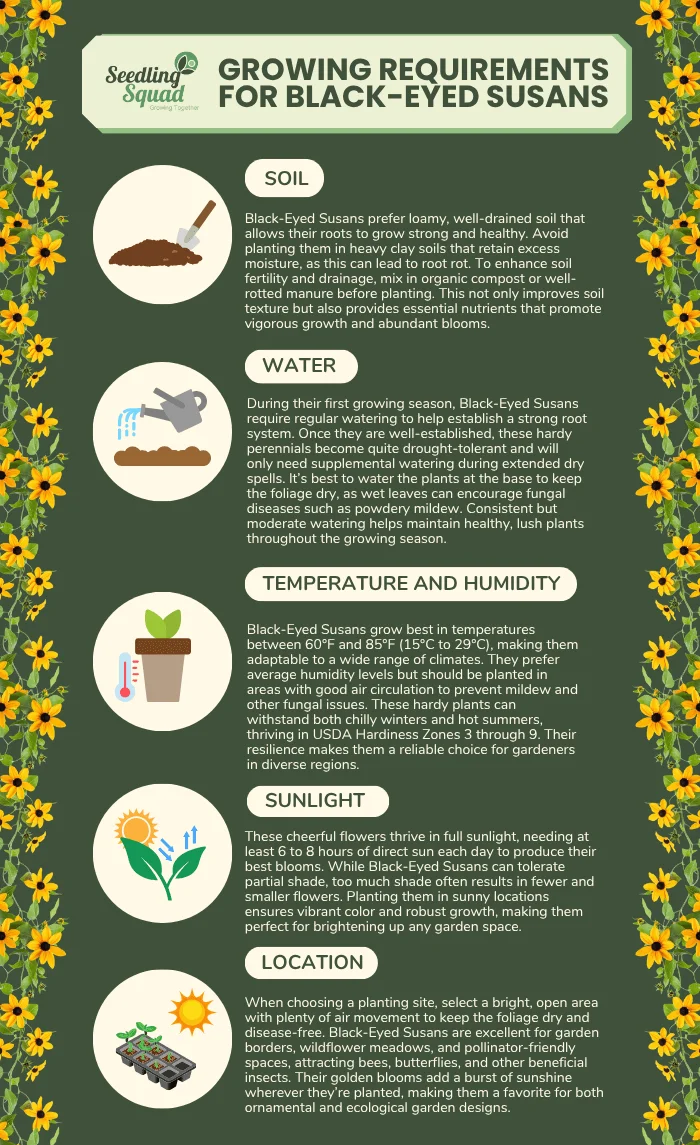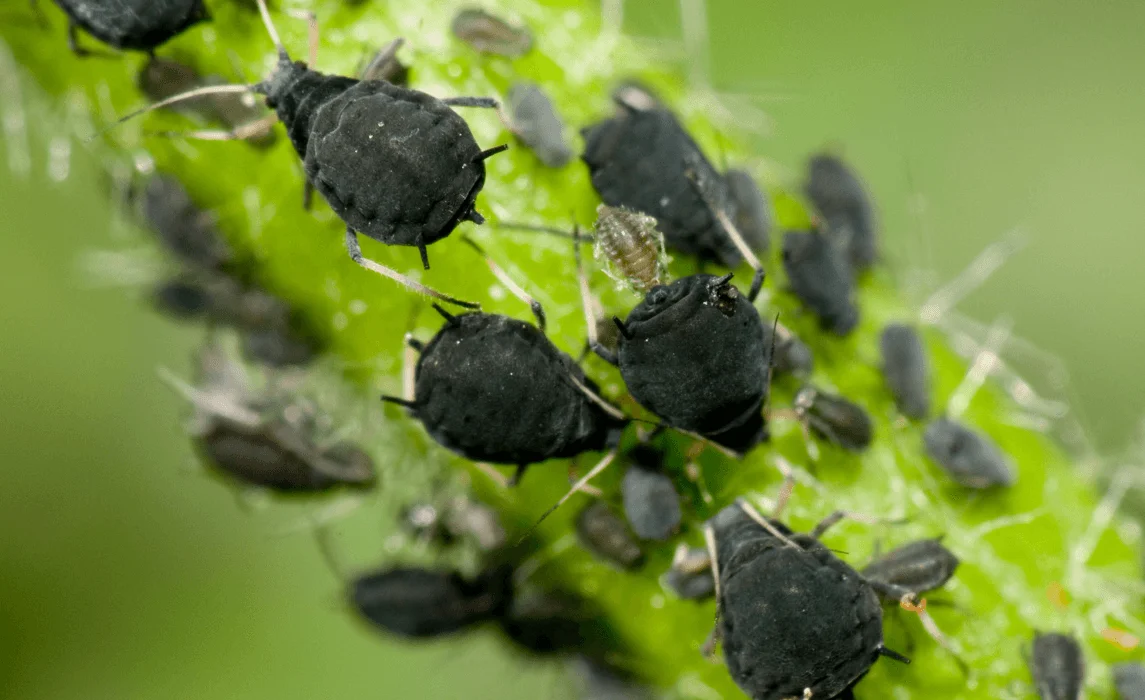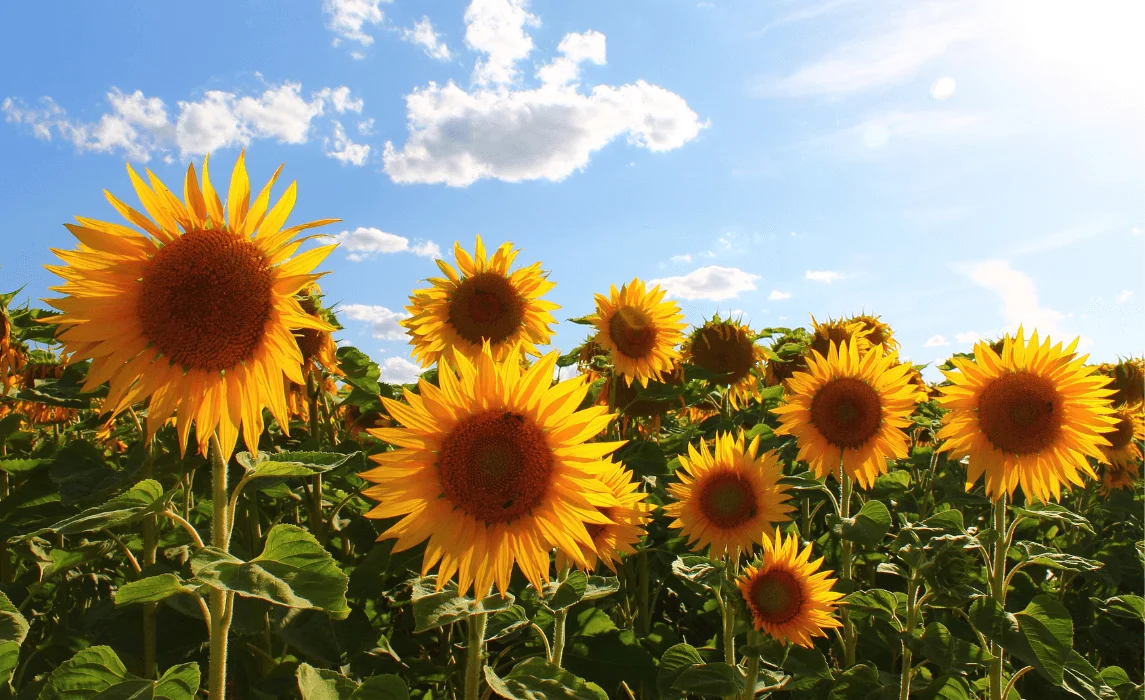How to Grow Beautiful Black-Eyed Susans and Make Your Garden Shine

1. Are black-eyed Susans perennials or annuals?
Rudbeckia hirta, the traditional black-eyed Susan, is a biennial or short-lived perennial that often acts like an annual due to self-seeding. Some cultivars like Rudbeckia fulgida are true perennials that return every year.
2. When do black-eyed Susans bloom?
They typically bloom from early summer to early fall, filling your garden with bright yellow petals and dark black eyes. Regular deadheading encourages continuous flowering throughout the season.
3. How do I plant black-eyed Susan seeds?
Scatter Rudbeckia hirta seeds directly on the soil surface and press them lightly, as they need light to germinate. Keep the soil moist, and seedlings will appear within 7–21 days.
4. Can I grow black-eyed Susans indoors or in containers?
Yes. You can grow black-eyed Susans in containers indoors or outdoors. Use a regular seed starting mix, ensure proper drainage, and place them in a sunny location for maximum blooms.
1. What do yellow flowers symbolize?
Yellow flowers often represent friendship, positivity, and joy. They’re ideal for celebrating success, expressing gratitude, or brightening someone’s day.
2. Do yellow flowers attract pollinators?
Absolutely! Sunflowers, coreopsis, and goldenrod are magnets for bees, butterflies, and other beneficial insects.
3. Can yellow flowers grow in partial shade?
Yes, lilies and calla lilies tolerate partial sunlight, making them great for slightly shaded gardens.
4. How can I extend the bloom time of yellow flowers?
Deadhead spent flower heads, keep soil nutrients balanced, and ensure proper watering to promote continuous blooms.
1. Why should I attract ladybugs to my garden?
Ladybugs act as natural pest controllers, consuming aphids, mites, and other harmful insects that damage plants. By inviting them, you reduce pesticide use and encourage a healthier ecosystem.
2. What do ladybugs eat?
Ladybugs primarily feed on aphids, but they also consume whiteflies, mealybugs, scale insects, and other soft-bodied pests that plague vegetable and flower gardens.
3. How can I keep ladybugs in my garden year-round?
To retain ladybugs, provide consistent food sources (such as aphid-prone plants), water, and shelter like mulch, bug hotels, or dense plantings. Avoid using chemical insecticides that can harm them.
If you’re looking to add a burst of sunshine to your garden, Black-Eyed Susans (Rudbeckia hirta) are the perfect choice. These cheerful, golden-yellow blooms with dark, velvety centers are not only easy to grow but also incredibly resilient. Whether you’re planting them from seeds or transplants, Black-Eyed Susans can thrive in a variety of conditions—bringing color, texture, and pollinator-friendly charm to any outdoor space. In this guide, we’ll walk you through how to grow beautiful Black-Eyed Susans step by step, from choosing the right soil and sunlight to caring for them season after season. Get ready to make your garden shine with these radiant, low-maintenance perennials that bloom all summer long.
- Plant Name: Black-Eyed Susan (Rudbeckia hirta)
- Plant Type: Biennial or short-lived perennial (self-seeding)
- Size: 1 to 3 feet tall, 12 to 18 inches wide
- Soil Type: Well-drained, loamy or sandy soil
- Soil pH: Slightly acidic to neutral (6.0–7.0)
- Bloom Time: Mid to late summer through early fall
- Hardiness Zones: USDA Zones 3–9
- Native Area: North America (prairies, meadows, and open woods)
- Toxicity Level: Non-toxic to humans and most pets (but can cause mild skin irritation in rare cases)
Best Black-Eyed Susan Varieties to Grow
While the traditional Rudbeckia hirta is the most common, several beautiful cultivars and varieties exist, each offering unique charm:
1. Rudbeckia hirta ‘Indian Summer’
This award-winning variety is prized for its massive golden-yellow blooms, which can reach up to 9 inches across—among the largest in the Rudbeckia family. The flowers feature a dark brown center that contrasts beautifully against the radiant petals, making it a stunning focal point in flower beds. ‘Indian Summer’ thrives in full sun and well-drained soil, blooming from mid-summer to fall, and attracts butterflies and bees in abundance.
2. Rudbeckia hirta ‘Cherokee Sunset’
If you’re looking for something more colorful, ‘Cherokee Sunset’ delivers a spectacular mix of warm tones, including shades of orange, bronze, gold, and deep red. Its semi-double to fully double blooms add texture and depth to garden displays or cut-flower arrangements. This variety grows about 24–30 inches tall, and its long-lasting blooms make it a favorite for late-summer borders and wildflower gardens.
3. Rudbeckia fulgida ‘Goldsturm’
Known as the gold standard of perennial Black-Eyed Susans, ‘Goldsturm’ is a low-maintenance and long-lived variety that blooms profusely from July to October. It features daisy-like golden flowers with dark centers, each about 3 inches wide, on sturdy, compact plants that reach around 24 inches in height. Ideal for mass plantings or edging pathways, ‘Goldsturm’ is also drought-tolerant once established and highly resistant to pests and diseases.
How to Plant Black-Eyed Susans (Step-by-Step)
.webp)
Planting black-eyed Susans is easy, even for beginners. Here’s how to plant them from seeds or seedlings:
From Seeds (Outdoors)
- Prepare the soil: Loosen the soil to about 12 inches deep and remove weeds.
- Improve texture: Mix in compost or sand for better drainage.
- Sow seeds: Scatter them on the soil surface — black-eyed Susan seeds need light to germinate, so do not cover them deeply.
- Press lightly: Gently press seeds into the soil using your palm or a board.
- Water well: Mist the soil to keep it moist (not soggy).
- Germination: Seeds usually germinate in 7–21 days when soil temperature is around 70–75°F (21–24°C).
From Seedlings (Indoors)
- Start seeds indoors 6–8 weeks before the last frost using a regular seed starting mix.
- Keep them in a warm, sunny spot or under grow lights.
- Once seedlings develop 2–3 true leaves, harden them off by gradually introducing them to outdoor sunlight over a week.
- Transplant seedlings outdoors, spacing each plant 12–18 inches apart.
Growing Requirements for Black-Eyed Susans

Soil
Black-Eyed Susans prefer loamy, well-drained soil that allows their roots to grow strong and healthy. Avoid planting them in heavy clay soils that retain excess moisture, as this can lead to root rot. To enhance soil fertility and drainage, mix in organic compost or well-rotted manure before planting. This not only improves soil texture but also provides essential nutrients that promote vigorous growth and abundant blooms.
Water
During their first growing season, Black-Eyed Susans require regular watering to help establish a strong root system. Once they are well-established, these hardy perennials become quite drought-tolerant and will only need supplemental watering during extended dry spells. It’s best to water the plants at the base to keep the foliage dry, as wet leaves can encourage fungal diseases such as powdery mildew. Consistent but moderate watering helps maintain healthy, lush plants throughout the growing season.
Sunlight
These cheerful flowers thrive in full sunlight, needing at least 6 to 8 hours of direct sun each day to produce their best blooms. While Black-Eyed Susans can tolerate partial shade, too much shade often results in fewer and smaller flowers. Planting them in sunny locations ensures vibrant color and robust growth, making them perfect for brightening up any garden space.
Temperature and Humidity
Black-Eyed Susans grow best in temperatures between 60°F and 85°F (15°C to 29°C), making them adaptable to a wide range of climates. They prefer average humidity levels but should be planted in areas with good air circulation to prevent mildew and other fungal issues. These hardy plants can withstand both chilly winters and hot summers, thriving in USDA Hardiness Zones 3 through 9. Their resilience makes them a reliable choice for gardeners in diverse regions.
Location
When choosing a planting site, select a bright, open area with plenty of air movement to keep the foliage dry and disease-free. Black-Eyed Susans are excellent for garden borders, wildflower meadows, and pollinator-friendly spaces, attracting bees, butterflies, and other beneficial insects. Their golden blooms add a burst of sunshine wherever they’re planted, making them a favorite for both ornamental and ecological garden designs.
Maintenance Tips for Healthy Black-Eyed Susans

Fertilizer
Black-Eyed Susans are low-maintenance when it comes to feeding and generally don’t require heavy fertilization. A simple application of compost or a slow-release, balanced fertilizer in spring is usually enough to keep them healthy and productive. Overfertilizing should be avoided, as it can lead to excessive leaf growth at the expense of flower production. Enriching the soil naturally with organic matter helps maintain long-term fertility while promoting strong stems and vibrant blossoms.
Pruning and Deadheading
Regular pruning and deadheading are key to keeping your Black-Eyed Susans blooming continuously throughout the growing season. Remove spent flowers promptly to encourage new buds and prolong flowering. After the first frost, cut the stems back to about 2 inches above the ground—this not only tidies up the garden but also prepares the plants for winter dormancy. Pruning also helps prevent unwanted self-seeding, especially if you prefer to control their spread within your garden.
Mulching
Applying mulch around the base of your Black-Eyed Susans is a great way to retain soil moisture, regulate temperature, and suppress weed growth. A 2-inch layer of organic mulch, such as shredded bark or compost, works best. Be sure to keep the mulch slightly away from the crown of the plant to prevent rot and ensure proper airflow. Mulching not only conserves water but also adds a neat, finished look to your garden beds.
Potting and Repotting
Black-Eyed Susans adapt well to container gardening, making them ideal for patios, balconies, or small spaces. Choose pots that are at least 12 inches deep with drainage holes to prevent waterlogging. Repot every 2–3 years or when the plants become crowded, dividing clumps to rejuvenate growth and encourage more blooms. Container-grown plants may require more frequent watering and occasional feeding compared to those grown in the ground.
Overwintering
In colder climates, protecting your Black-Eyed Susans during winter helps ensure a strong comeback in spring. After cutting back the foliage in late fall, apply a layer of mulch or straw around the base of the plants to insulate the roots from freezing temperatures. In spring, remove the mulch and prune away any remaining dead stems to make room for new growth. In milder regions, these resilient perennials can overwinter naturally outdoors without additional protection, returning each year with renewed vigor.
Common Pests and Diseases
Common Pests

Aphids
Aphids are small, soft-bodied insects that suck sap from plant tissues, often causing curled leaves or a sticky residue known as honeydew. These pests can attract ants and promote mold growth if left unchecked. To control aphids, spray the plants with a strong stream of water to dislodge them or apply insecticidal soap or neem oil for more persistent infestations. Regularly inspecting your plants can help catch these pests early.
Leaf Miners
Leaf miners are tiny larvae that burrow into leaves, leaving behind squiggly white trails. While they rarely kill the plant, severe infestations can weaken it and affect its appearance. To treat leaf miner damage, remove and destroy the affected leaves to prevent larvae from maturing. Applying neem oil can also help deter adult insects from laying eggs on the foliage.
Common Diseases

Powdery Mildew
Powdery mildew is one of the most common fungal problems affecting Black-Eyed Susans. It appears as a white, powdery coating on the leaves, often starting on the lower foliage before spreading upward. This disease is usually caused by high humidity and poor air circulation. To prevent it, ensure your plants are well-spaced and always water at the base to keep the leaves dry. If infection occurs, remove and dispose of affected leaves promptly, then treat the plant with neem oil or a mild fungicide to stop the spread.
Black Spot
Black spot is another fungal disease characterized by round black or brown spots on the leaves. It typically develops when the foliage stays damp for extended periods, especially in humid or rainy conditions. To prevent black spot, avoid overhead watering and ensure the plants have plenty of airflow. When detected early, prune and discard the affected leaves; for severe cases, apply a copper-based fungicide to control the outbreak.
Angular Leaf Spot
Angular leaf spot causes dark, angular patches on the leaves, which can weaken the plant if left untreated. This disease spreads through contaminated water or tools. To manage it, promptly remove any infected foliage and sanitize garden tools after pruning to prevent reinfection. Maintaining clean garden practices goes a long way in keeping fungal diseases under control.
How to Harvest and Collect Seeds
Although Black-Eyed Susans aren’t grown for food, collecting their seeds is a rewarding way to propagate new plants, share them with fellow gardeners, or expand your garden’s cheerful display year after year. These hardy perennials produce plenty of seeds, making it easy to save and replant them for future blooms.
To begin, wait until the flower heads have fully dried and turned brown at the end of the growing season. This indicates that the seeds inside have matured and are ready for collection. Using clean, sharp scissors or pruning shears, carefully snip off the dried seed heads and place them in a paper bag. Avoid using plastic bags, as they can trap moisture and cause mold.
Once collected, shake the bag gently to release the seeds from the heads. You can also rub the heads lightly between your fingers to loosen stubborn seeds. After separating them, allow the seeds to air-dry for a few days to ensure they’re completely dry before storage. Store the dried seeds in a labeled envelope or airtight container, keeping them in a cool, dry, and dark place until you’re ready to plant in spring.
If you’d like to support local wildlife, consider leaving some of the seed heads on the plants through winter. The seeds serve as a valuable food source for birds and small animals, while the dried stalks add texture and interest to your winter garden. By collecting and preserving seeds responsibly, you can enjoy the beauty of Black-Eyed Susans season after season while also giving back to nature.
Frequently Asked Questions:
1. Are black-eyed Susans perennials or annuals?
Rudbeckia hirta, the traditional black-eyed Susan, is a biennial or short-lived perennial that often acts like an annual due to self-seeding. Some cultivars like Rudbeckia fulgida are true perennials that return every year.
2. When do black-eyed Susans bloom?
They typically bloom from early summer to early fall, filling your garden with bright yellow petals and dark black eyes. Regular deadheading encourages continuous flowering throughout the season.
3. How do I plant black-eyed Susan seeds?
Scatter Rudbeckia hirta seeds directly on the soil surface and press them lightly, as they need light to germinate. Keep the soil moist, and seedlings will appear within 7–21 days.
4. Can I grow black-eyed Susans indoors or in containers?
Yes. You can grow black-eyed Susans in containers indoors or outdoors. Use a regular seed starting mix, ensure proper drainage, and place them in a sunny location for maximum blooms.






